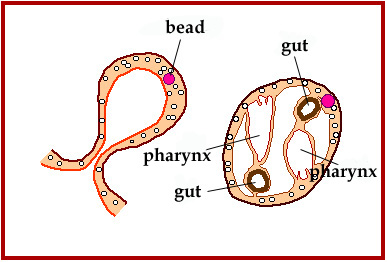
Introduction
The gut is formed in the most proximal region
of the normally developing bud.
When a retinoic acid-containing bead is implanted
into the distal region,
an additional gut is formed near the bead, resulting
in the complete duplication
of the entire body axis.

The activity of aldehyde dehydrogenase (ALDH,
potential retinoic acid synthase)
is detected in the proximal region of the normally
developing bud.
The amount of retinal is greatly reduced in the
developing bud.
These observations suggest that retinoic acid
is an endogenous determinant
directing transdifferentiation of the atrial
epithelium
References
Fujiwara,S. & Kawamura,K. (1992) Ascidian
budding as a
transdifferentiation-like
system: multipotent epithelium is not
undifferentiated. Dev.
Growth Differ. 34: 463-472.
Hara,K., Fujiwara,S. & Kawamura,K. (1992)
Retinoic acid can induce a
secondary axis in developing
buds of a colonial ascidian, Polyandrocarpa
misakiensis. Dev. Growth
Differ. 34: 437-445.
Kawamura,K., Hara,K. & Fujiwara,S. (1993)
Developmental role of
endogenous retinoids
in the determination of morphallactic field in
budding tunicates. Development
117: 835-845.
Kawamura,K. & Fujiwara,S. (1994) Transdifferentiation
of pigmented
multipotent epithelium
during morphallactic development of budding
tunicates.
Int. J. Dev. Biol. 38: 369-377.
To reveal mechanism of transdifferentiation in
the developing bud,
we are investigating expression and function
of ALDHs and retinoid receptors.
We are also interested in genes that are activated
by retinoic acid.
Impressed? Go to the following pages!